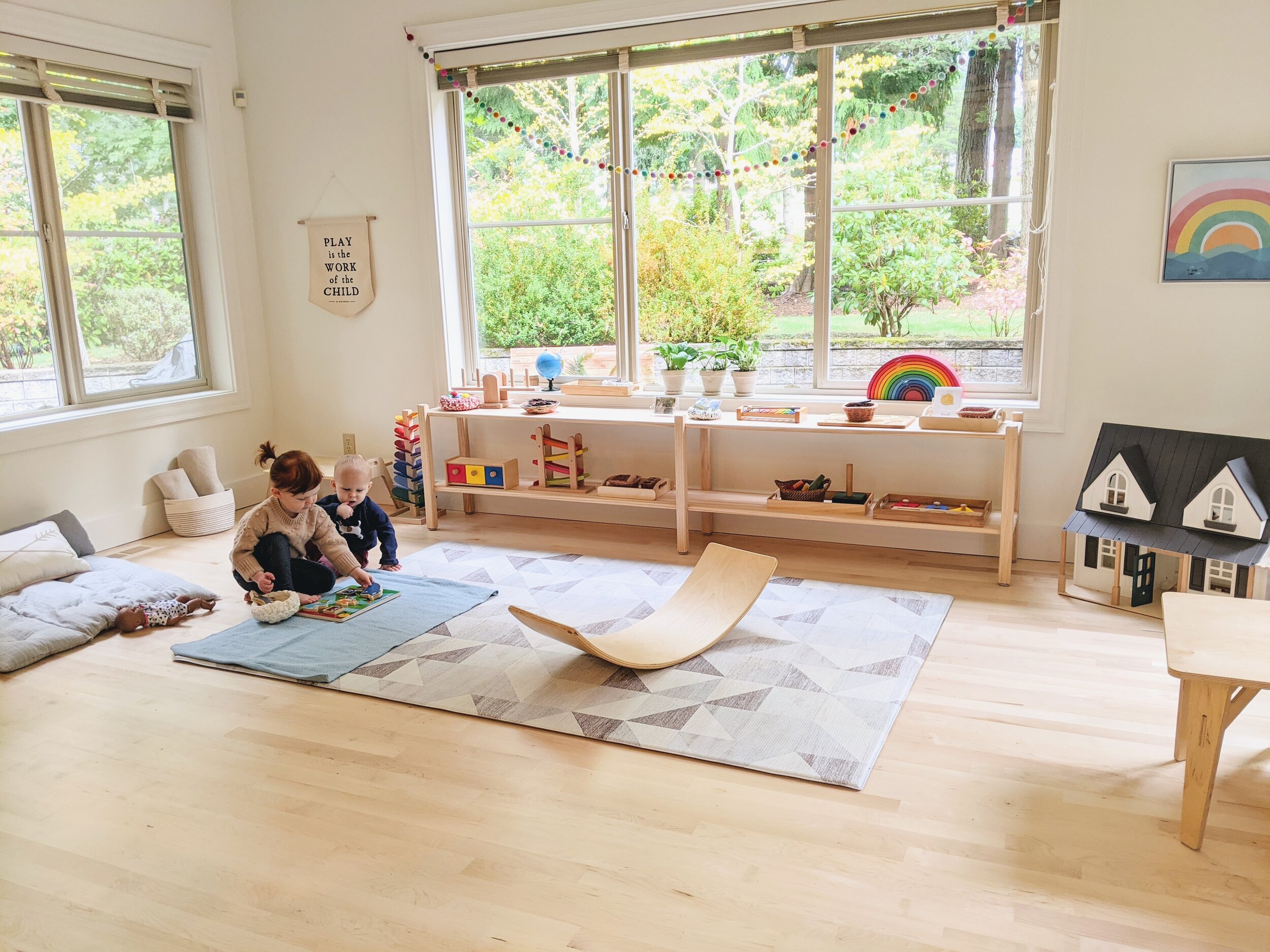A Montessori Approach to "Clean-up Time"
Montessori in Real Life
“How do you get your kids to clean up after themselves??” This is one of my most frequently asked questions. And one of the most frequent comments parents have when observing a Montessori classroom or home is how tidy it is. There are a few reasons for this.
Maria Montessori believed in providing a beautiful and orderly environment for children. Young children are able to focus better and feel more at peace when their spaces are clean.
Less clutter allows for more movement in the shared space.
Children are a part of the community, and that means we all help each other keep our shared space clean and safe. This includes cleaning up after ourselves.
Children are more willing to help clean up after themselves in a classroom vs. a home because rules and expectations are often more clear at school, and home is where they know they are safest and comfortable. That being said, there are many ways we can help our children, even toddlers, consistently clean up after themselves when playing at home too. Most children are capable of cleaning up after themselves by 18 months, but children can be increasingly independent with age and practice.
Have a place for everything - It is very important to have a specfic spot for everything. Our children can only put toys and materials away if they know exactly where it goes. It is especially helpful for children if they can see what’s available just by looking at the shelf, e.g. books facing outward, materials on trays, and toys in clear bins or wire baskets (see Polished Playhouse post!)
Only put out what they can put away - This often means minimizing what is out at a time. The amount that is displayed depends on the child - their age and their current interest in dumping vs. cleaning up after themselves. In general, less is more. A toddler can put away 8 blocks, but not 48. I always encourage rotating materials more often and having less out at one time to prevent toy and mess overload.
Model it - We are our children’s best role models and they are ALWAYS watching. If we slowly model putting a material back on the shelf before we choose a new one, they are far more likely to do so too. It is also helpful to think about how we model tidying up after ourselves throughout the day. If we leave our own spaces cluttered, they are more likely to as well.
Make it part of the routine - The more we incorporate it into our day, the less of an issue it becomes. Most days, clean up happens naturally as we play. The children know that we put one work away before choosing the next. When they are busy playing independently with open-ended toys, they know that we clean up before rest time, or at least before bedtime.
Wait for a Natural Pause - It’s important not to interrupt a child who is concentrating with something to remind them to put a work away. If my child hasn’t put a work away and has already moved on, I wait until they are done with the new work before pointing out the one that need to be put away. This lets them know we respect their work and their concentration while still following through on clean-up.
Especially in a home versus a classroom, there are times when the children are playing independently, particularly with open-ended toys, when toys aren’t put away one at a time. This isn’t a bad thing, but it can lead to a bigger mess, and one that is harder for young children to initiate clean-up with. For S (17 mos), I simply continue to model. With D (3), here are some strategies I use:
Frame in the positive - When simple reminders are needed, I try to phrase in the positive instead of the negative. Instead of saying “You can’t ___ until you clean up!” I’d frame it in a positive light, e.g. “After you put these toys away we can make snack together!" That subtle difference makes a big difference.
Play a bell or Sing a song - Something about music makes everything feel easier and lighter. One tip is to ring a bell when it’s clean up time. Another is to sing a simple song together. These little tricks can make a big difference.
At the end of the day, we pick up toys, pick up toys, pick up toys
At the end of the day, we pick up toys, and put them all away.
Tomorrow we’ll take some out again, out again, out again
Tomorrow we’ll take some out again, and have fun when we play!
Offer choices - When there are toys all over, and it’s feeling overwhelming, it’s helpful to break it down and offer choices. For example, "Would you like to put away the blocks or trains? You choose." I typically help by cleaning up the one she doesn’t choose first.
Empathize - On that note, it’s important to show compassion. If our child is tired or hungry or just having a hard day, it’s okay to let the clean-up expectations go. In these instances I’ll say "It's been a long day. You can help or stay close to me while I tidy this up." That way, D is still involved in the process, seeing empathy modeled, but not forced into cleaning.
Keep in mind that all of this is a gradual process. I always recommend starting small, and giving them a little more responsibilty as they get used to being an active participant in the clean-up process. Our patience is key to clean-up being a positive and natural follow-up to play, rather than a battle of wills!



